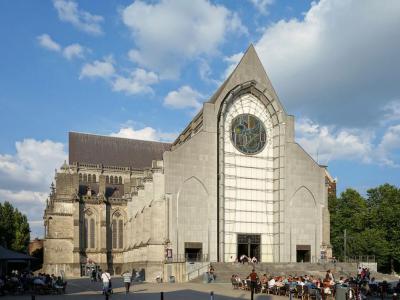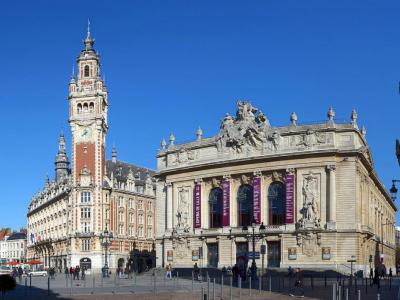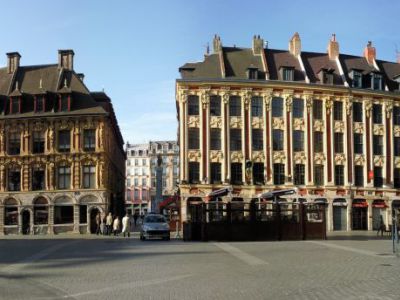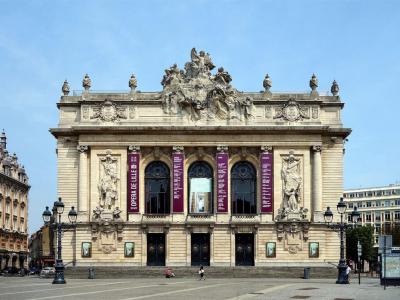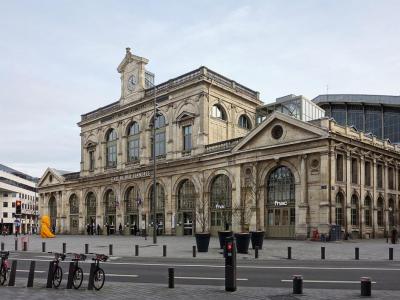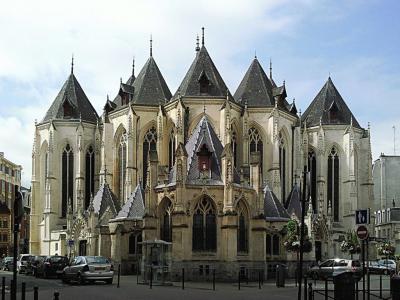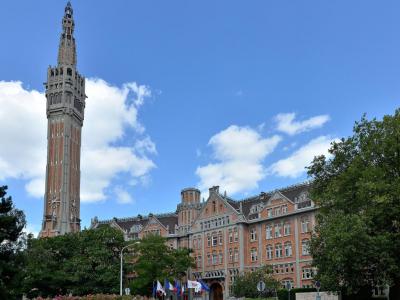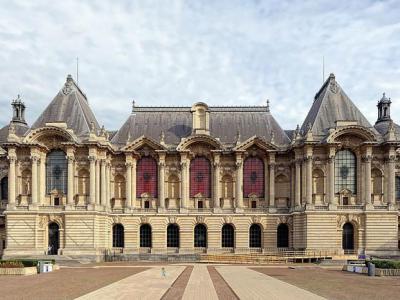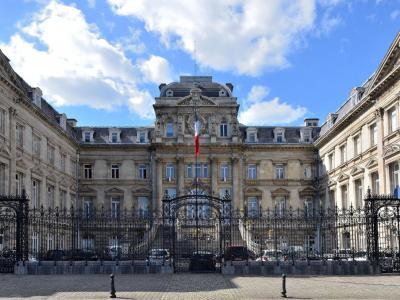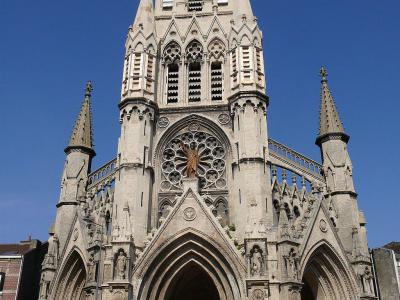
Lille's Historical Buildings Tour (Self Guided), Lille
Historically, Lille's architecture differs from that of other French cities. Prior to being invaded by Louis XIV in 1667, Lille was Flemish, which is evident in its red-brick and other structures, quite uncommon for the rest of France.
Among many things, Lille is reputed for its fabulous historic center, abounding in time-honored buildings, palaces, and churches, offering a great deal of insight into the city's glorious past. Remarkably restored, the Old Town enchants visitors with its delicately gabled roofs and flamboyant, softly dare facades setting off the exuberance and profusion of their decoration.
If you’re on the hunt for culture, there's plenty of it in Lille, set in stone of the numerous, centuries-old and uniquely designed buildings. Here are some of them not to miss:
The Palais des Beaux-Arts (Palace of Fine Arts) – an impressive 19th-century edifice, home to one of the richest museums in France, second only to the Louvre, overlooking the equally grand Préfecture building.
The Chamber of Commerce – the Neo-Flemish-style building constructed between 1910 and 1921.
Le Rang du Beauregard (Beauregard Row) – a stunning example of 17th-century French architecture.
Opéra de Lille – a magnificent Neoclassical theatre built in 1907-1913.
Gare de Lille Flandres – the city’s main railway station, constructed from 1869 to 1892.
Beffroi de l'Hôtel de ville de Lille (Belfry of Lille Town Hall Belfry) – the tallest municipal building in France, with a belfry that has no bells.
Église du Sacré-Cœur de Lille (Sacred Heart Church) – a 19th-century Neo-Gothic Roman Catholic church, one of the largest temples in Lille.
To explore these and other monumental attractions, and to discover the magnificent flavor of Lille’s architecture, take this self-guided walking tour.
Among many things, Lille is reputed for its fabulous historic center, abounding in time-honored buildings, palaces, and churches, offering a great deal of insight into the city's glorious past. Remarkably restored, the Old Town enchants visitors with its delicately gabled roofs and flamboyant, softly dare facades setting off the exuberance and profusion of their decoration.
If you’re on the hunt for culture, there's plenty of it in Lille, set in stone of the numerous, centuries-old and uniquely designed buildings. Here are some of them not to miss:
The Palais des Beaux-Arts (Palace of Fine Arts) – an impressive 19th-century edifice, home to one of the richest museums in France, second only to the Louvre, overlooking the equally grand Préfecture building.
The Chamber of Commerce – the Neo-Flemish-style building constructed between 1910 and 1921.
Le Rang du Beauregard (Beauregard Row) – a stunning example of 17th-century French architecture.
Opéra de Lille – a magnificent Neoclassical theatre built in 1907-1913.
Gare de Lille Flandres – the city’s main railway station, constructed from 1869 to 1892.
Beffroi de l'Hôtel de ville de Lille (Belfry of Lille Town Hall Belfry) – the tallest municipal building in France, with a belfry that has no bells.
Église du Sacré-Cœur de Lille (Sacred Heart Church) – a 19th-century Neo-Gothic Roman Catholic church, one of the largest temples in Lille.
To explore these and other monumental attractions, and to discover the magnificent flavor of Lille’s architecture, take this self-guided walking tour.
How it works: Download the app "GPSmyCity: Walks in 1K+ Cities" from Apple App Store or Google Play Store to your mobile phone or tablet. The app turns your mobile device into a personal tour guide and its built-in GPS navigation functions guide you from one tour stop to next. The app works offline, so no data plan is needed when traveling abroad.
Lille's Historical Buildings Tour Map
Guide Name: Lille's Historical Buildings Tour
Guide Location: France » Lille (See other walking tours in Lille)
Guide Type: Self-guided Walking Tour (Sightseeing)
# of Attractions: 10
Tour Duration: 2 Hour(s)
Travel Distance: 3.7 Km or 2.3 Miles
Author: rose
Sight(s) Featured in This Guide:
Guide Location: France » Lille (See other walking tours in Lille)
Guide Type: Self-guided Walking Tour (Sightseeing)
# of Attractions: 10
Tour Duration: 2 Hour(s)
Travel Distance: 3.7 Km or 2.3 Miles
Author: rose
Sight(s) Featured in This Guide:
- Lille Cathedral
- Chambre de Commerce (Chamber of Commerce)
- Le Rang du Beauregard (Beauregard Row)
- Opéra de Lille (Lille Opera)
- Gare de Lille Flandres (Lille-Flandres Railway Station)
- Église Saint-Maurice de Lille (St. Maurice Church)
- Beffroi de l'Hôtel de ville de Lille (Belfry of Lille Town Hall Belfry)
- Palais des Beaux-Arts (Palace of Fine Arts)
- Préfecture de Lille (Lille Prefecture)
- Église du Sacré-Cœur de Lille (Sacred Heart Church)
1) Lille Cathedral (must see)
The miraculous statue of the Virgin Mary of the Trellis made its home in the Collegiate Church of Saint Peter from the 13th century until 1792. The gilded iron trellis wrapped around the statue was lost in the upheavals of the French Revolution. The statue was recovered and placed in the church of St Catherine, its iron trellis replaced with a wooden one.
In 1853 Charles-Kolb Bernard and his cousin formed a commission to build a fabulous new church in honor of Our Lady of the Treille. Land in the center of Lille was set aside for the construction. The 13th century Gothic styles shown by the cathedrals in Reims, Amiens and Chartres were pressed on the architects and builders.
At first the task was intimidating. It called for a building 433 feet long and spires reaching to 377 feet. The proportions were too large, the budget too small. The cathedral's main facade was not completed until the 1990s. The center is made of an ogive 96 feet high faced with 110 sheets of thick white marble.
A rose window dedicated to the Resurrection is by Ladislas Kijno. The main iron doorway was created by Georges Jeanclos. It is an enormous neo-Gothic building with a bold modern facade designed by architects Pierre-Louis Carlier and Peter Rice. In addition to services, the cathedral hosts concerts and it has a Sacred Art Center in its crypt.
The Cathedral is open all year. Guided tours are available.
In 1853 Charles-Kolb Bernard and his cousin formed a commission to build a fabulous new church in honor of Our Lady of the Treille. Land in the center of Lille was set aside for the construction. The 13th century Gothic styles shown by the cathedrals in Reims, Amiens and Chartres were pressed on the architects and builders.
At first the task was intimidating. It called for a building 433 feet long and spires reaching to 377 feet. The proportions were too large, the budget too small. The cathedral's main facade was not completed until the 1990s. The center is made of an ogive 96 feet high faced with 110 sheets of thick white marble.
A rose window dedicated to the Resurrection is by Ladislas Kijno. The main iron doorway was created by Georges Jeanclos. It is an enormous neo-Gothic building with a bold modern facade designed by architects Pierre-Louis Carlier and Peter Rice. In addition to services, the cathedral hosts concerts and it has a Sacred Art Center in its crypt.
The Cathedral is open all year. Guided tours are available.
2) Chambre de Commerce (Chamber of Commerce)
The Chamber of Commerce (Chambre de Commerce) in Lille housed within the Nouvelle Bourse building, stands as a prominent architectural and historical landmark. Constructed over 11 years from 1910 to 1921, it is situated directly across from the Old Stock Exchange (Vieille Bourse) on the Theater Square (Place du Théâtre). Designed by architect Louis Marie Cordonnier, the New Stock Exchange (Nouvelle Bourse) was intended to serve as the headquarters for the Chamber of Commerce and Industry of Greater Lille, an institution that was founded in 1715.
Architecturally, the building exemplifies Neo-Flemish style, drawing inspiration from the grand Dutch town halls of the past. This style is apparent in its rich decorative elements, including plant motifs and scrolls reminiscent of 17th-century Lille. One of the most striking features of the building is its 76-meter-high belfry, adorned with a four-dial clock and an automated carillon that includes 26 bells weighing a total of 2000 kg, cast in 1984 by Luigi Bergamo of the Cornille-Havard foundry.
The interior of the building is equally impressive, with a 25x25-meter hall of honor that boasts colonnaded galleries and a 17-meter high dome, lavishly decorated with exquisite frescoes. The building also houses several important rooms used for various functions, including a 300-seat auditorium known as the Descamps room, Reception rooms, the Sessions room, and the Committee room or the Kuhlmann office, which are also richly decorated with frescoes and woodwork.
In recognition of its architectural and historical significance, the Chamber of Commerce and Industry building was listed as a historic monument in 2015. This designation underscores its importance not only as a center of commerce and industry but also as a key part of Lille’s cultural and historical heritage.
Architecturally, the building exemplifies Neo-Flemish style, drawing inspiration from the grand Dutch town halls of the past. This style is apparent in its rich decorative elements, including plant motifs and scrolls reminiscent of 17th-century Lille. One of the most striking features of the building is its 76-meter-high belfry, adorned with a four-dial clock and an automated carillon that includes 26 bells weighing a total of 2000 kg, cast in 1984 by Luigi Bergamo of the Cornille-Havard foundry.
The interior of the building is equally impressive, with a 25x25-meter hall of honor that boasts colonnaded galleries and a 17-meter high dome, lavishly decorated with exquisite frescoes. The building also houses several important rooms used for various functions, including a 300-seat auditorium known as the Descamps room, Reception rooms, the Sessions room, and the Committee room or the Kuhlmann office, which are also richly decorated with frescoes and woodwork.
In recognition of its architectural and historical significance, the Chamber of Commerce and Industry building was listed as a historic monument in 2015. This designation underscores its importance not only as a center of commerce and industry but also as a key part of Lille’s cultural and historical heritage.
3) Le Rang du Beauregard (Beauregard Row)
Beauregard Row (Le Rang du Beauregard) is an impressive example of 17th-century French architecture located on Theater Square (Place du Théâtre) in Lille and has been a protected historic monument since 1966. Constructed from 1685 to 1687 by contractor Simon Vollant based on designs by architect Julien Destrée, it consists of a line of 14 two-bay houses. These houses replaced earlier wooden structures that had been there since 1551. In 1674, local authorities mandated that new buildings must match the style of nearby structures, including the Old Stock Exchange, leading to a design featuring three floors and an attic.
Similar to the Old Stock Exchange, the base of the building features sandstone arches, above which are three stories made of stone and brick topped with a mansard roof. The design of the façade, with its simple lines and subtle color and pattern choices, blends traditional French classical styles introduced after Lille was taken over by Louis XIV in 1667 with local Flemish influences, creating a unique Franco-Lille style.
The area got its name, Beauregard, from a viewing platform built by the Duke of Burgundy, Philippe Le Bon, in 1425, which stood across from the site until it was taken down in 1651. There are differing stories about how the name Beauregard came to be, with the most accepted theory being that the term "belvedere" might not have been commonly used to mean 'beauregard' during the 15th century.
On the right side of the façade, you can still see about a dozen cannonballs embedded in the wall. These are relics from the 1792 siege of Lille when over 30,000 cannonballs were fired at the city. One notable cannonball, which struck the Morel brewery, has been humorously painted pink and shaped to look like a breast.
Similar to the Old Stock Exchange, the base of the building features sandstone arches, above which are three stories made of stone and brick topped with a mansard roof. The design of the façade, with its simple lines and subtle color and pattern choices, blends traditional French classical styles introduced after Lille was taken over by Louis XIV in 1667 with local Flemish influences, creating a unique Franco-Lille style.
The area got its name, Beauregard, from a viewing platform built by the Duke of Burgundy, Philippe Le Bon, in 1425, which stood across from the site until it was taken down in 1651. There are differing stories about how the name Beauregard came to be, with the most accepted theory being that the term "belvedere" might not have been commonly used to mean 'beauregard' during the 15th century.
On the right side of the façade, you can still see about a dozen cannonballs embedded in the wall. These are relics from the 1792 siege of Lille when over 30,000 cannonballs were fired at the city. One notable cannonball, which struck the Morel brewery, has been humorously painted pink and shaped to look like a breast.
4) Opéra de Lille (Lille Opera)
The Lille Opera (Opéra de Lille) is an example of Neoclassical architecture, seamlessly integrated with the adjacent Chamber of Commerce and Old Stock Exchange. The current structure was erected from 1907 to 1913 after its predecessor, dating back to 1785, was destroyed by fire in 1903.
The design of the new opera house was the vision of architect Louis Marie Cordonnier, selected through a competitive process. His Belle Époque style is evident in the building's grand façade, which features an elaborate pediment relief crafted by Hippolyte Lefèbvre. This is complemented by two bas-relief panels on either side, created by Alphonse-Amédée Cordonnier and Hector Lemaire. The interior of the opera house is equally striking, showcasing the artistic contributions of the prominent sculptor Edgar-Henri Boutry.
However, the building's completion was marred by the events of World War I. In July 1914, German forces occupying Lille requisitioned the still unfinished opera house, stripping it of its furniture and equipment to outfit the local Sebastopol Theatre. It wasn't until after the war that the opera house was fully restored, reopening in 1923 as the Grand Theatre. This reopening was celebrated with a French premiere (première française), marking a new chapter in its history.
The theatre again faced challenges in 1998 when it was forced to close mid-season due to deteriorating physical conditions. This closure led to an extensive renovation project aimed not only at restoring the building but also at enhancing its functional capacities. The renovation was completed in 2004, coinciding with Lille's designation as the European Capital of Culture, thus affirming the Opéra de Lille's status as a cultural and architectural landmark in the region.
The design of the new opera house was the vision of architect Louis Marie Cordonnier, selected through a competitive process. His Belle Époque style is evident in the building's grand façade, which features an elaborate pediment relief crafted by Hippolyte Lefèbvre. This is complemented by two bas-relief panels on either side, created by Alphonse-Amédée Cordonnier and Hector Lemaire. The interior of the opera house is equally striking, showcasing the artistic contributions of the prominent sculptor Edgar-Henri Boutry.
However, the building's completion was marred by the events of World War I. In July 1914, German forces occupying Lille requisitioned the still unfinished opera house, stripping it of its furniture and equipment to outfit the local Sebastopol Theatre. It wasn't until after the war that the opera house was fully restored, reopening in 1923 as the Grand Theatre. This reopening was celebrated with a French premiere (première française), marking a new chapter in its history.
The theatre again faced challenges in 1998 when it was forced to close mid-season due to deteriorating physical conditions. This closure led to an extensive renovation project aimed not only at restoring the building but also at enhancing its functional capacities. The renovation was completed in 2004, coinciding with Lille's designation as the European Capital of Culture, thus affirming the Opéra de Lille's status as a cultural and architectural landmark in the region.
5) Gare de Lille Flandres (Lille-Flandres Railway Station)
Lille-Flandres Railway Station (Gare de Lille Flandres) is the primary railway station in Lille, renowned for its significant historical and architectural value. The station's building, showcasing a Neoclassical design, was conceived by architects Léonce Reynaud and Sidney Dunnett, affiliated with the Chemins de fer du Nord (Northern Railway Company). A unique aspect of its construction is the front façade, which was originally part of Paris’s Gare du Nord. This façade was meticulously dismantled and reassembled at Lille, imbuing the station with a Parisian architectural heritage.
The origins of the station date back to 1848 when it was inaugurated with just a ground floor. It was later expanded in 1867 to include an additional floor and a striking pediment featuring a large clock. This addition was timed to align with the creation of the Place de la Gare, enhancing the station's prominence and its surroundings.
Subsequent years saw further enhancements to the station's infrastructure. In 1880, renovations included the replacement of the old roof over the waiting lounge. The heating system was expanded, and in 1883, the waiting hall underwent a complete redecoration. By 1887, the Hôtel des Voyageurs was integrated into the station's complex, followed by the addition of a new rooftop in 1892.
Today, Lille-Flandres holds the distinction of being the busiest TER (regional train) station in France outside of Paris and is second only to Lyon-Part-Dieu station in terms of provincial attendance. The name "Flandres" was appended in 1993, coinciding with the opening of the nearby Lille-Europe station, situated on the high-speed LGV Nord line, to help distinguish it from its modern counterpart. This station not only serves as a crucial transport hub but also as a historical landmark reflecting the rich railway heritage of northern France.
The origins of the station date back to 1848 when it was inaugurated with just a ground floor. It was later expanded in 1867 to include an additional floor and a striking pediment featuring a large clock. This addition was timed to align with the creation of the Place de la Gare, enhancing the station's prominence and its surroundings.
Subsequent years saw further enhancements to the station's infrastructure. In 1880, renovations included the replacement of the old roof over the waiting lounge. The heating system was expanded, and in 1883, the waiting hall underwent a complete redecoration. By 1887, the Hôtel des Voyageurs was integrated into the station's complex, followed by the addition of a new rooftop in 1892.
Today, Lille-Flandres holds the distinction of being the busiest TER (regional train) station in France outside of Paris and is second only to Lyon-Part-Dieu station in terms of provincial attendance. The name "Flandres" was appended in 1993, coinciding with the opening of the nearby Lille-Europe station, situated on the high-speed LGV Nord line, to help distinguish it from its modern counterpart. This station not only serves as a crucial transport hub but also as a historical landmark reflecting the rich railway heritage of northern France.
6) Église Saint-Maurice de Lille (St. Maurice Church)
Saint Maurice Church, located on Paris Street in Lille, features both Gothic and Neo-Gothic architectural styles. The construction spanned almost five centuries, beginning in the late 14th century and concluding in the late 19th century.
The earliest record of a church at this location, known as Saint Maurice de Fins, is from 1066. It details the founding of the collegiate church of Saint Peter, which was financed by the church of Saint Maurice. Although the precise origin date of Saint Maurice de Fins is unclear, it's possibly linked to a public tribunal held in Lille in 875, but the 1066 charter indicates it might have been established later. No evidence of earlier churches in the vicinity exists.
There's speculation that Saint Maurice was built atop a Roman temple dedicated to Mars, which would explain its unusual dedication within the Tournai diocese. The term "Fins" in its name is derived from the Latin "fines," meaning border or frontier.
During the French Revolution, the church was plundered, but it recovered some of its confiscated items and paintings from local convents in the early 19th century. Noteworthy among these are works by Jakob van Oost the Younger (1639-1713) and Louis Joseph Watteau (1731-1798), depicting various religious scenes.
The church also houses the grave of Charles Ferdinand d'Artois, Duke of Berry, who was assassinated in 1820. He was the youngest son of Charles X, the King of France, and Maria Theresa of Savoy.
In the 19th century, under the direction of Philippe Cannissié, the church underwent restoration. It was enhanced with Neo-Gothic furniture and new stained glass windows, and it was declared a historic monument in 1840.
The earliest record of a church at this location, known as Saint Maurice de Fins, is from 1066. It details the founding of the collegiate church of Saint Peter, which was financed by the church of Saint Maurice. Although the precise origin date of Saint Maurice de Fins is unclear, it's possibly linked to a public tribunal held in Lille in 875, but the 1066 charter indicates it might have been established later. No evidence of earlier churches in the vicinity exists.
There's speculation that Saint Maurice was built atop a Roman temple dedicated to Mars, which would explain its unusual dedication within the Tournai diocese. The term "Fins" in its name is derived from the Latin "fines," meaning border or frontier.
During the French Revolution, the church was plundered, but it recovered some of its confiscated items and paintings from local convents in the early 19th century. Noteworthy among these are works by Jakob van Oost the Younger (1639-1713) and Louis Joseph Watteau (1731-1798), depicting various religious scenes.
The church also houses the grave of Charles Ferdinand d'Artois, Duke of Berry, who was assassinated in 1820. He was the youngest son of Charles X, the King of France, and Maria Theresa of Savoy.
In the 19th century, under the direction of Philippe Cannissié, the church underwent restoration. It was enhanced with Neo-Gothic furniture and new stained glass windows, and it was declared a historic monument in 1840.
7) Beffroi de l'Hôtel de ville de Lille (Belfry of Lille Town Hall Belfry) (must see)
Has there ever been a belfry without bells? If no bells, why a belfry? That is a question for wiser heads. We know of a belfry with no bells. In Lille, France, the town hall belfry is the tallest municipal building in France and it has no bells.
The belfry tower was inaugurated in 1932. It is part of a reconstruction project to replace the old town hall, destroyed in World War I. It was built by architect Emile Dubuisson. Dubuisson was inspired to resonate his style with the traditional triangular gables of old Flemish houses.
The belfry is built of red bricks and concrete. It is slender and modernistic, attached to the stolid, grandiose town hall. They make a strange but harmonious ensemble. The city had previously three other bell towers. One was demolished in 1601. Another in 1856. The last came down in the Great War.
The current town hall and its tower were erected off-center, in the depressed Saint-Sauver district as a part of an urban renewal project of Socialist Mayor Gustave Delory.
The hall and the belfry show Classic Art-Deco and neo-Flemish elements common to the region. The tower utilizes a sculptured stone style of reinforced concrete. This allows for more strength. The belfry rises to a height of 338 feet. If you love heights, at the top there is a belvedere with nets. It is windy and high, an adventure!
The belfry tower was inaugurated in 1932. It is part of a reconstruction project to replace the old town hall, destroyed in World War I. It was built by architect Emile Dubuisson. Dubuisson was inspired to resonate his style with the traditional triangular gables of old Flemish houses.
The belfry is built of red bricks and concrete. It is slender and modernistic, attached to the stolid, grandiose town hall. They make a strange but harmonious ensemble. The city had previously three other bell towers. One was demolished in 1601. Another in 1856. The last came down in the Great War.
The current town hall and its tower were erected off-center, in the depressed Saint-Sauver district as a part of an urban renewal project of Socialist Mayor Gustave Delory.
The hall and the belfry show Classic Art-Deco and neo-Flemish elements common to the region. The tower utilizes a sculptured stone style of reinforced concrete. This allows for more strength. The belfry rises to a height of 338 feet. If you love heights, at the top there is a belvedere with nets. It is windy and high, an adventure!
8) Palais des Beaux-Arts (Palace of Fine Arts) (must see)
Facing the fountains enclosing the sculpture "Group Of Three" on the Republic Square, is the Palace of Fine Arts. On the other side of the square is the imposing limestone structure, the Prefecture of Lille.
The museum is a grandiose building made in a French end of century style of official architecture. It has elements of the Italian Renaissance with columns, pediments and a French roof. There are two domed pavilions on either side of the monumental façade. The façade is set off with moldings. The wings have loggias and balusters.
The original museum was established by Napoleon in 1801. The Emperor's decree selected 15 French cities to house art seized from churches and occupied lands. The new Museum was opened in 1892 and renovated extensively in 1997. The museum now has 71,500 square feet of exhibition space making it one of the largest museums in France.
The ground floor has military fortification models by Sebastien de Vauban, the famous military engineer of Louis XIV. Sebastien shares this space with 135 French sculptures. On the second floor (French first floor) is a collection of Flemish and Dutch paintings. There are 19th century French paintings from David to Toulouse-Lautrec.
The Museum possesses over 70,000 pieces of Art. The collection includes works by Raphael, Donatello, Van Dyck, Rembrandt, Goya, El Greco, Delacroix, Rubens, Rodin and Chardin, to mention a few.
The museum is a grandiose building made in a French end of century style of official architecture. It has elements of the Italian Renaissance with columns, pediments and a French roof. There are two domed pavilions on either side of the monumental façade. The façade is set off with moldings. The wings have loggias and balusters.
The original museum was established by Napoleon in 1801. The Emperor's decree selected 15 French cities to house art seized from churches and occupied lands. The new Museum was opened in 1892 and renovated extensively in 1997. The museum now has 71,500 square feet of exhibition space making it one of the largest museums in France.
The ground floor has military fortification models by Sebastien de Vauban, the famous military engineer of Louis XIV. Sebastien shares this space with 135 French sculptures. On the second floor (French first floor) is a collection of Flemish and Dutch paintings. There are 19th century French paintings from David to Toulouse-Lautrec.
The Museum possesses over 70,000 pieces of Art. The collection includes works by Raphael, Donatello, Van Dyck, Rembrandt, Goya, El Greco, Delacroix, Rubens, Rodin and Chardin, to mention a few.
9) Préfecture de Lille (Lille Prefecture)
The Lille Prefecture (Préfecture de Lille) is a sprawling architectural site featuring a main building complete with a ceremonial courtyard and adjoining park, alongside two additional wings. At the forefront of the main structure, constructed from hard limestone, stands an elegant fountain. The design follows a Classical style, enriched with numerous allegorical figures adorning the pediments.
This architectural ensemble was developed over the years from 1865 to 1905. The design was spearheaded by Charles Marteau, a notable local architect. The sculpted pediments were crafted by Félix Huidiez, while the garden behind the buildings, which was added in 1874 and is surrounded by a tall brick wall with stone accents, was designed by Georges Aumont, a landscape architect responsible for numerous parks in Lille and Roubaix. In 1905, Léonce Hainez, a regional architect, made additional changes and improvements.
Situated on land that once housed city fortifications (removed in 1865), the site now overlooks the Palace of Fine Arts (Palais des Beaux-Arts), constructed twenty years later. It serves as a critical link between the historic Old Town of Lille and newer areas incorporated in 1858.
The layout of the premises is based on an "H plan," designed to accommodate a variety of functions including the Prefect's residence, office spaces, and rooms for hosting distinguished visitors. The facility also includes areas for various administrative services, a secretariat, and a celebration hall. The interiors are decorated with numerous artworks, including sculptures, paintings, and murals.
Since 1975, the Prefecture building has been recognized as a historical monument.
This architectural ensemble was developed over the years from 1865 to 1905. The design was spearheaded by Charles Marteau, a notable local architect. The sculpted pediments were crafted by Félix Huidiez, while the garden behind the buildings, which was added in 1874 and is surrounded by a tall brick wall with stone accents, was designed by Georges Aumont, a landscape architect responsible for numerous parks in Lille and Roubaix. In 1905, Léonce Hainez, a regional architect, made additional changes and improvements.
Situated on land that once housed city fortifications (removed in 1865), the site now overlooks the Palace of Fine Arts (Palais des Beaux-Arts), constructed twenty years later. It serves as a critical link between the historic Old Town of Lille and newer areas incorporated in 1858.
The layout of the premises is based on an "H plan," designed to accommodate a variety of functions including the Prefect's residence, office spaces, and rooms for hosting distinguished visitors. The facility also includes areas for various administrative services, a secretariat, and a celebration hall. The interiors are decorated with numerous artworks, including sculptures, paintings, and murals.
Since 1975, the Prefecture building has been recognized as a historical monument.
10) Église du Sacré-Cœur de Lille (Sacred Heart Church)
The Church of the Sacred Heart, one of Lille's largest churches, measures 90 meters in length, and 24 meters in width, and rises to 22 meters at its highest point. It was built in response to a promise made by the Association of the Children of Mary of the Sacred Heart on October 7, 1870, to protect Lille from the Prussian invasion during wartime.
Constructed in the Neo-Gothic style by architect Jules Batigny, the church's construction occurred in two stages. The initial phase, from 1875 to 1878, was followed by a second, from 1895 to 1898. This later phase included the addition of the apsidal chapel, known as the Chapel of the Vow, positioned behind the choir and featuring eleven stained glass windows. This expansion was inspired by another pledge by local women to build a chapel dedicated to the Sacred Heart, aimed at providing a dedicated space for reflection within the church.
The church was officially consecrated on June 20, 1902. At that time, its bell tower was still incomplete. It now contains a carillon, although the bells have not rung for several years. The tower, designed by architect Charles Sarazin and standing at 75 meters tall, was finished in 1928. It is constructed of reinforced concrete, which deteriorated due to weather conditions and required complete restoration from 2005 to 2008.
In April 2018, the church was temporarily closed for worship for six months by a city order due to dry rot. To date, only seven of its canopies have been restored, while the remaining five are still in disrepair and waiting to be fixed.
Since 1983, the building has been recognized as a National Historic Monument.
Constructed in the Neo-Gothic style by architect Jules Batigny, the church's construction occurred in two stages. The initial phase, from 1875 to 1878, was followed by a second, from 1895 to 1898. This later phase included the addition of the apsidal chapel, known as the Chapel of the Vow, positioned behind the choir and featuring eleven stained glass windows. This expansion was inspired by another pledge by local women to build a chapel dedicated to the Sacred Heart, aimed at providing a dedicated space for reflection within the church.
The church was officially consecrated on June 20, 1902. At that time, its bell tower was still incomplete. It now contains a carillon, although the bells have not rung for several years. The tower, designed by architect Charles Sarazin and standing at 75 meters tall, was finished in 1928. It is constructed of reinforced concrete, which deteriorated due to weather conditions and required complete restoration from 2005 to 2008.
In April 2018, the church was temporarily closed for worship for six months by a city order due to dry rot. To date, only seven of its canopies have been restored, while the remaining five are still in disrepair and waiting to be fixed.
Since 1983, the building has been recognized as a National Historic Monument.
Walking Tours in Lille, France
Create Your Own Walk in Lille
Creating your own self-guided walk in Lille is easy and fun. Choose the city attractions that you want to see and a walk route map will be created just for you. You can even set your hotel as the start point of the walk.
Lille Introduction Walking Tour
Nicknamed in France the "Capital of Flanders", Lille and its surroundings belong to the historical region of Romance Flanders. Legend has it that in 620 AD, Salvaert, Prince of Dijon, passed through the region with his pregnant wife when he was attacked and killed by the local lord Phinaert The Giant. Years later, his son Lyderic avenged his father by killing the Giant and founded the... view more
Tour Duration: 2 Hour(s)
Travel Distance: 4.0 Km or 2.5 Miles
Tour Duration: 2 Hour(s)
Travel Distance: 4.0 Km or 2.5 Miles
The Most Popular Cities
/ view all
